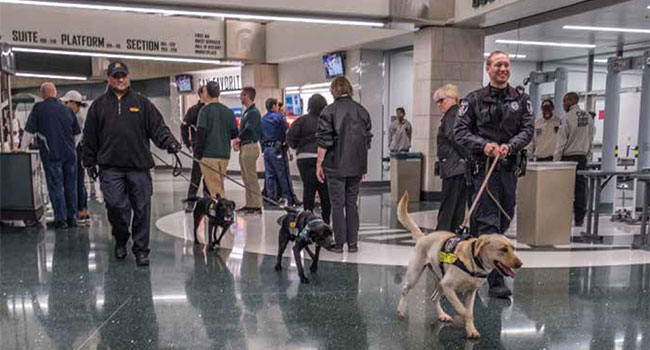
The Most Effective Detection Technology
Universities nationwide are using Auburn-created Vapor Wake Technology to keep campuses safer
- By Janet McCoy
- June 01, 2018
Michigan State University and Notre Dame are fierce
competitors, but off the field, they are among university
police departments nationwide who join
forces by employing specially trained Vapor Wake
K-9s with one goal: keeping campuses safe.
Along with Auburn University, whose faculty created the patented
Vapor Wake technology, California State University Northridge
(CSUN) and others have purchased canines or used this advanced
canine detection on campuses.
MOST EFFECTIVE TECHNOLOGY
Vapor Wake detection is a method of training and employing dogs for
the detection of body-worn and hand-carried explosives. Developed
and patented by Auburn University, Vapor Wake dogs are specially
trained to continuously sample the air for an explosive target, then
follow it to its source in real time, while the target is in motion.
While the dogs are commonly used at Amtrak stations, professional
sports stadiums and in other crowded venues, Michigan State and
Notre Dame are among a handful of universities which have purchased
Vapor Wake canines to keep the public safe.
“Vapor Wake dogs are ideal for security in large event venue scenarios,”
said Dr. Paul Waggoner, co-director of Canine Performance
Sciences, a division of the Auburn University College of Veterinary
Medicine. “Auburn’s excited to know other universities are adopting
Vapor Wake technology. It broadens the application and extends collaboration
and the science behind the detection.”
Waggoner, a canine behavioral scientist, says dogs, “represent the
most capable and effective technology for the detection of most hazardous
materials, particularly explosives.
“No instrumentation has been developed that is as capable as the
dog, and certainly not as flexible as the dog, in terms of circumstances
under which it can be used and its ability to detect an odor at very low
concentration, and then, most importantly, track that odor to its
source.”
Waggoner stresses that these dogs remain the most effective technology
for detecting threats.
SOLVING THE PROBLEM
Waggoner, who is one of the creators of the Vapor Wake technology,
said researchers and scientists were “presented the problem of how to
better protect areas from hand carried and body-worn explosives.”
“We approached it by developing a canine detection technology
solution (and) understanding the human thermal and aerodynamic
wake that is emitted from a person,” Waggoner said. “Whether you’re carrying a backpack or it is attached to your body, as you move forward,
you leave a wake of odor, including the odor of the explosive,
behind you. The technology we developed has a dog sampling the wake
and detecting explosives and tracking that explosives to its source.”
Auburn University patented the technology, one of the first ever of
canine detection methodology, and licensed the technology to a private
company, VWK9, to transfer the technology into a user community.
In addition to handling the purchase of vapor wake dogs, VWK9
conducts the operational detection dog training and handler training,
as well as provide Vapor Wake K9 Team services to large events, such
as concerts and sporting events.
“Fans feel safer," said Paul Hammond, president of VWK9. "They see
our non-obtrusive Labradors screening all that enter the event and
often comment on how well the dogs are preforming and how much
safer they feel by their presence.”
The VW dog is a high level detection dog. Auburn’s CPS program
includes a research breeding program for which the Vapor Wake capable
dog is the standard (or target) to which they strive to achieve: currently,
about 60 percent of the dogs CPS produces are capable of Vapor
Wake methodology.
“By contrast, in the general population, only one in about 100
dogs bred and trained for general detection dog tasks, could be
capable of performing vapor wake canine,” Waggoner added. “CPS
is recognized worldwide for the development canine detection technology;
and the program is unique in that it brings together science
and application in the development of new technology
and in understanding how dogs perform
detection work.”
This article originally appeared in the June 2018 issue of Campus Security Today.
About the Author
Janet McCoy is the Director of Communications & Marketing at Auburn University’s College of Veterinary Medicine.